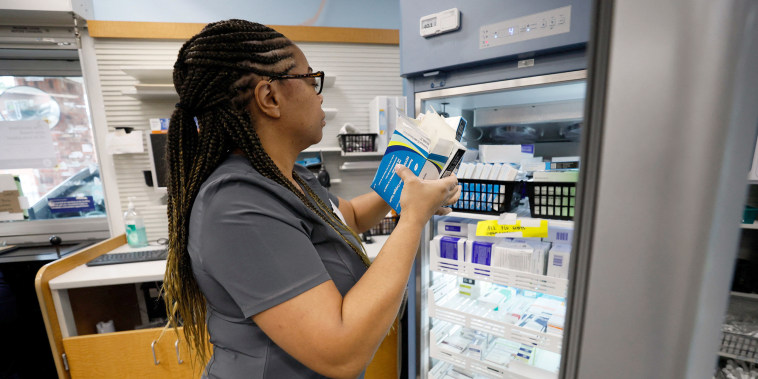People with prescriptions to fill could run into an unexpected snag over the next couple of days, as hundreds of pharmacists may call out of work to protest working conditions at CVS and Walgreens.
Organizers of the ‘Pharmageddon’ protest told NBC News that around 900 people in as many as 10 states could participate in the ongoing protest, which started Monday and will end Wednesday. There was no way to independently verify that number.
Lannie Duong, a clinical pharmacist based in California, is one of the key organizers of the protests. She said that, along with sickouts and walkouts, members have discussed protesting at the corporate headquarters of Walgreens and CVS, which are in Deerfield, Illinois, and Woonsocket, Rhode Island, respectively. Those protests are scheduled for Wednesday.
The protests are that much more notable because the pharmacists don’t have a union and aren’t asking for better pay. They primarily want their employers to hire more staff to alleviate the workload and to eliminate policies that push them to work faster. They say those conditions are making it more likely they will make a mistake that could harm a patient.
Pharmacists and other health care workers have complained about those issues for years, even before the Covid-19 pandemic, which made them worse. But the current pharmacy protests started attracting notice after at least a dozen CVS stores in the Kansas City area refused to show up for work in mid-September. They’ve spread since then.
CVS pharmacist Estrella Clemons pulls vaccines from a fridge in North Decatur, Ga., on Sept. 20.Miguel Martinez / TNS/ABACA via Reuters file
Pressure behind the counter
An operations manager at a Nebraska Walgreens spoke to NBC News about those issues. They manage their store’s pharmacy and asked that their name not be used because of worries that the company may retaliate against them.
They said the store’s sole pharmacist and its pharmacy technicians constantly have to stop what they’re doing to cover other jobs within the pharmacy. It’s the only way to prevent long lines of annoyed customers, but it’s a distracting environment.
‘My pharmacist at any point has three or four customers waiting for him to do something with their prescription, whether it be double-checking it or consulting,’ they said. ‘Every single one of us is jumping from customer to customer to customer all day long.’
That causes more mistakes, like errors in counting out pills. The operations manager said their store’s pharmacy fills about 450 prescriptions in a typical nine-hour day. For about half of those, the pills have to be counted out one by one.
They also said the pharmacy technicians usually don’t take breaks and, for many years, the operations manager didn’t either. They said the increasingly tough working conditions are being combined with meager pay raises.
According to the operations manager, their store fills far more prescriptions than it used to, and at the same time, vaccinations have become a bigger and bigger part of the company’s business. The manager said they give about 45 vaccinations in a typical eight-hour shift, which translates into 1 every 10 minutes or so.
‘It’s definitely gone downhill, especially since the pandemic,’ they said. ‘I’m tired of leaving the front and going and crying in the pharmacy, drying my tears and then giving people a shot.’
The manager added that their pharmacist supports the protest, but doesn’t plan to go on strike. The pharmacy part of the store wouldn’t be able to open at all without them.
Walgreens said only two pharmacies were closed on Monday and one remained shuttered on Tuesday. The company also said it is listening to employees’ concerns and frustrations.
‘We recognize the incredible work our pharmacists and technicians do every day and have taken a number of steps in our pharmacies to ensure that our teams can concentrate on providing optimal patient care,’ the company said in a statement.
CVS said it was not seeing any ‘unusual activity’ connected to store closures or walkouts. It said it has made changes to address some of the past complaints.
‘In response to recent feedback from our pharmacy teams, we’re making targeted investments to address their key concerns, including enabling teams to schedule additional support as needed, enhancing pharmacist and technician recruitment and hiring, and strengthening pharmacy technician training,’ the company said in a statement.
Al Carter, executive director of the National Association of Boards of Pharmacy and a former practicing pharmacist, said drugstores can’t control how much they are paid for filling prescriptions. (The payments are made by prescription benefit managers, and Walgreens and CVS each own a large player in that industry.) But they can control their spending on employees’ pay, so they run the tightest ships they can.
Employees say it’s far too tight, especially with their responsibilities growing, community pharmacies closing, and the three largest U.S. chains all in the process of closing stores.
In a news statement Monday, American Pharmacists Association CEO Michael D. Hogue said the group stands with the pharmacists who went on strike.
‘For far too long, employers have made the situation worse than it needed to be,’ he wrote, adding that quotas requiring pharmacists to fill a certain number of prescriptions or administer large numbers of vaccinations are destroying their relationships with patients.
‘Supervisors who are not pharmacists do not understand the needs of care teams and make unreasonable demands on time-based productivity,” Hogue said.

